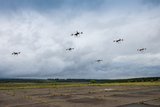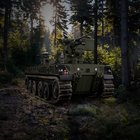Airbus launches Zephyr 8 project
Airbus Defence and Space announced on 23 April that it had launched the Zephyr 8 programme to develop the next generation of the world record setting Zephyr 7 UAS. The company added that it is inviting potential customers and partners to undertake joint inflight demonstrations of their payloads and applications.
The company has classed the high altitude long endurance UAS as a High Altitude Pseudo-Satellite (HAPS). Running solely on solar power and flying at high altitudes above the weather and above conventional air traffic Airbus says that it fills a capability gap between satellites and UAVs.
The Airbus Group has been working on HAPS since 2008. A cross-divisional "Nursery" project was created in which an integrated team of space and aviation experts has incubated a HAPS business addressing all its technical, commercial and regulatory aspects.
In 2013, this incubator acquired the assets of the Zephyr programme, which had originally been initiated in the UK, and integrated all the key Zephyr staff into its HAPS organisation. The Zephyr programme successfully achieved several world records, including the longest flight duration without refuelling full 14 days, as well as very high altitude flights of 70,740ft.
The current Zephyr 7 vehicle underwent final testing last year before the design of a complete suite of improvements for the next generation, the new Airbus Zephyr 8.
‘I am delighted with the progress,’ said Jens Federhen, Airbus HAPS Programme Manager. ‘We are now building the next generation of Airbus Zephyr that will allow customers to test payloads and applications. We are ready and look forward to demonstrating its unique capabilities to customers in flight.’
‘Zephyr 7 is demonstrably years ahead of any other HAPS system and we spent last year analysing and designing exactly what we need to improve it’ explained Airbus Zephyr Technical Director, Chris Kelleher. ‘We received permissions to fly and have flown Zephyrs in Australia, USA and Europe, and now have a well-defined flight and safety procedure that has already been accepted by four major test ranges.’
Federhen added that customers do not need to be worried about making payloads that are fit for the harsh stratospheric environment, ‘we can help them design, build and operate the payload if necessary, or provide a defined interface and then integrate the payload with the aircraft and fly it to test the payload, demonstrate the application and develop the flight procedures.’
More from Uncrewed Vehicles
-
![Ready for the race: Air separation drone swarms vs. air defence systems]()
Ready for the race: Air separation drone swarms vs. air defence systems
As the dynamics of aerial combat rapidly evolve, Chinese scientists have engineered a sophisticated air separation drone model that can fragment into up to six drones, each capable of executing distinct battlefield roles and challenging the efficacy of current anti-drone defences such as the UK’s Dragonfire laser system.
-
![Israel’s MALE UAVs ‘must adapt’ to Iranian-made air defences]()
Israel’s MALE UAVs ‘must adapt’ to Iranian-made air defences
Advancements in air defence technologies have begun to reshape aerial combat dynamics in the Middle East, as illustrated by recent events involving the Israeli Air Force and Hezbollah.
-
![Hundreds more UAS sent to Ukraine forces with thousands more on the way]()
Hundreds more UAS sent to Ukraine forces with thousands more on the way
Both sides of the Russia-Ukraine war have been using UAS for effective low-cost attacks, as well as impactful web and social media footage. Thousands more have now been committed to Ukrainian forces.
-
![AI and software companies selected for US Army Robotic Combat Vehicle subsystems]()
AI and software companies selected for US Army Robotic Combat Vehicle subsystems
The US Army has intentions to develop light, medium and heavy variants of the Robotic Combat Vehicle (RCV) as part of the branche’s Next Generation Combat Vehicle family.
-
![DroneShield to improve software of DroneSentry-X C-UAS system under new contract]()
DroneShield to improve software of DroneSentry-X C-UAS system under new contract
DroneSentry-X, a cross-vehicle compatible, automated 360° C-UAS detect and defeat device, can offer 360° awareness and protection using integrated sensors. According to its manufacturer, it is suitable for mobile operations, on-site surveillance and on-the-move missions.
-
![Ukraine takes delivery of new indigenous C-UAS systems]()
Ukraine takes delivery of new indigenous C-UAS systems
Funded by the country’s former president, the new C-UAS systems will be sent to the frontline where they have already been tested against Russian invading forces.


























